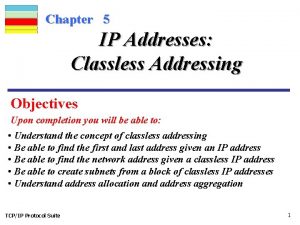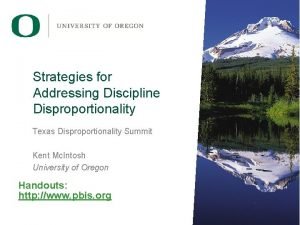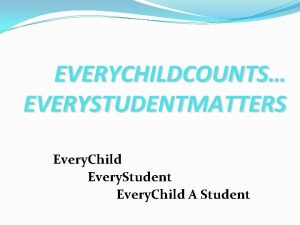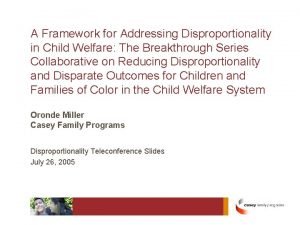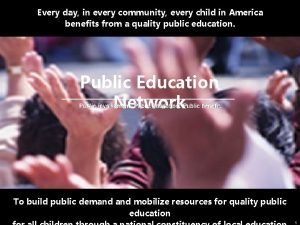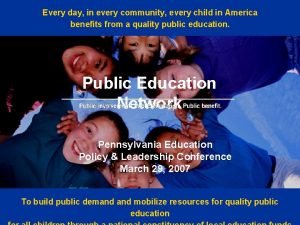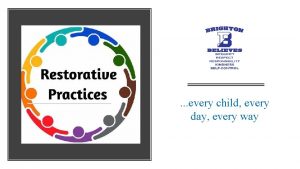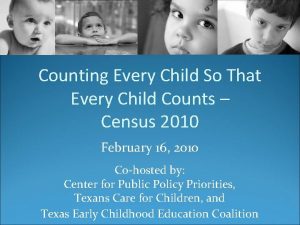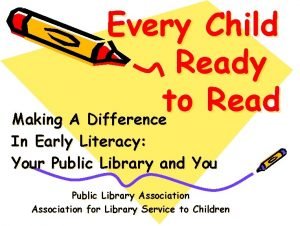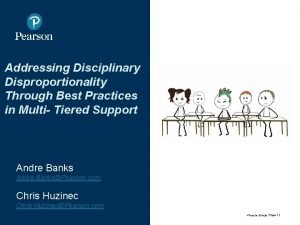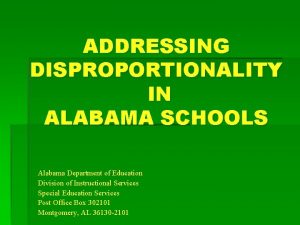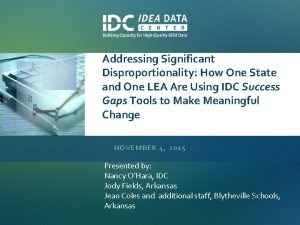Making a difference for every child Addressing disproportionality
















- Slides: 16

Making a difference for every child: Addressing disproportionality in all its forms Pedro A. Noguera, Ph. D. New York University

Distinguishing between symptoms and causes § Racial disparities are a symptoms of larger systemic problems § Troubling assumptions: Danger of locating problem in students § Unmet social needs - Truancy studies show concerns about safety, lack of transportation and work influence attendance § Resentment and lack of preparation to respond to demographic change § Underlying causes: Systemic failures in the ways schools respond to student needs, no advocates for equity § Normalization of failure - Must find ways to challenge beliefs about race and achievement

Typical areas of concern related to equity § § § Achievement patterns Special Education placements Discipline referrals English language learners Equity – Is about insuring that resources are allocated based upon need and that the opportunity to learn is met for all students § outcomes and results

Key questions: Asking the right questions is essential to developing effective responses § Achievement: § Who is teaching our most vulnerable students? § Are they well trained? Do they receive adequate support? § When do signs of trouble first appear? § Are there barriers that deny access to curriculum or school resources? § How should we target our interventions? § Examples: 9 th grade academy, placing strong reading teachers in 3 rd grade

Special Education § What is the profile of the students who are targeted for referrals? § What do we know from assessments about these students? § What will we do to insure that their identified needs are met? § Is there fidelity in the implementation of the IEP? § Are the teachers serving them trained/supported? § Who are the advocates for these children?

Discipline referrals § Which students are being referred? For what reasons? § What underlying factors may be influencing problematic behavior? § What interventions might be most effective at changing the behavior?

II. The Failure of Reform: Learning from our mistakes § Many school reforms have not been implemented with a clear focus on how they will solve the most pressing problems facing schools § Structural changes: Small learning communities § Most school reforms fail to address the culture of schools § Too top down - Not enough “buy-in” from staff § Insufficient evaluation § Must examine the way failure becomes normalized - So Much Reform, Why So Little Change - Charles Payne

Reducing disproportionality requires a change in how schools operate § Need for early intervention systems – § Minneapolis identifies 3 rd graders who are at risk of dropping out § Quality counseling and advising § Need for partnerships between schools and CBOs § Address non-academic needs – health and safety § Need to personalize the learning environment § Size matters - schools where students are known § Meet learning needs of students - EPGY

What We Know: Certain students are at greater risk of failing § Teen mothers § English language learners, recent immigrants (late arrivers) § Over-age middle school students § Under-prepared high school students - low literacy skills, low credits § Students with frequent absences § Bored and alienated students

III. What can be done to reduce racial disparities? § Improve teaching - Move away from excessive reliance on lecture and test prep § Interactive strategies - project-based learning, Socratic seminars, experiential learning, simulations, presentations § Make class time work time - reduce reliance on homework, teachers must look for evidence of learning § Deploy subject matter coaches to classrooms

Students in control of learning at Hollenbeck Middle School, LA

Don’t treat special education as a place, treat it as a way to meet student needs § When possible deploy special ed teachers to regular ed classrooms § Least restrictive environment § Must be time for collaborative planning § Insure that teachers and aides are well trained § Reinforce classroom-based interventions with specialists

Other strategies for reducing disparities § Make curriculum more relevant to the lives of students § Vocational education - career academies linked to private industry; marketable skills that don’t limit options - internships § Cultural relevance - build connections between what is learned and what is familiar to students § Show what is learned in school can help students to address real problems in their lives § Knowledge for empowerment

Strategies continued § Help students to develop concrete plans for the future early § Involve students in counseling about college early § Engage parents in advising § Build stronger ties between adults and students § Effective use of extracurricular activities § Develop small learning communities § Pro-active mentoring § Utilize every teacher as an advisor § Design systems to identify at-risk students and to intervene early § Target at-risk youth with mentors, jobs, and services § Utilize after-school and intensive summer school programs

PS 28 obtains highest gains in literacy and math in Brooklyn -2012

Keep in Mind § Changing school culture is the most important thing that can be done to keep students in school § Build community § Adopt rituals and practices that reinforce values and norms that promote achievement § Counter anti-intellectualism so that its “cool to be smart” § We may need to adopt alternative pathways to diplomas for students who cannot fit into traditional school structures and schedules § GED is an important option for some students § Districts should not be penalized if they allow students to stay in school past the age of 18
 Every child every day
Every child every day Flat addressing vs hierarchical addressing
Flat addressing vs hierarchical addressing Every nation and every country has its
Every nation and every country has its Microsoft empower every person
Microsoft empower every person Every knee shall bow every tongue confess
Every knee shall bow every tongue confess Every rotarian every year
Every rotarian every year Every nation and every country
Every nation and every country Every picture has a story and every story has a moment
Every picture has a story and every story has a moment Difference between classful and classless addressing
Difference between classful and classless addressing Classless and classful
Classless and classful Nparks every child a seed
Nparks every child a seed Every child a seed
Every child a seed Why was every child matters scrapped
Why was every child matters scrapped Every child matters honouring and remembering
Every child matters honouring and remembering Pta every child one voice
Pta every child one voice Every mother loves her child tag question
Every mother loves her child tag question Every child matters be healthy
Every child matters be healthy









